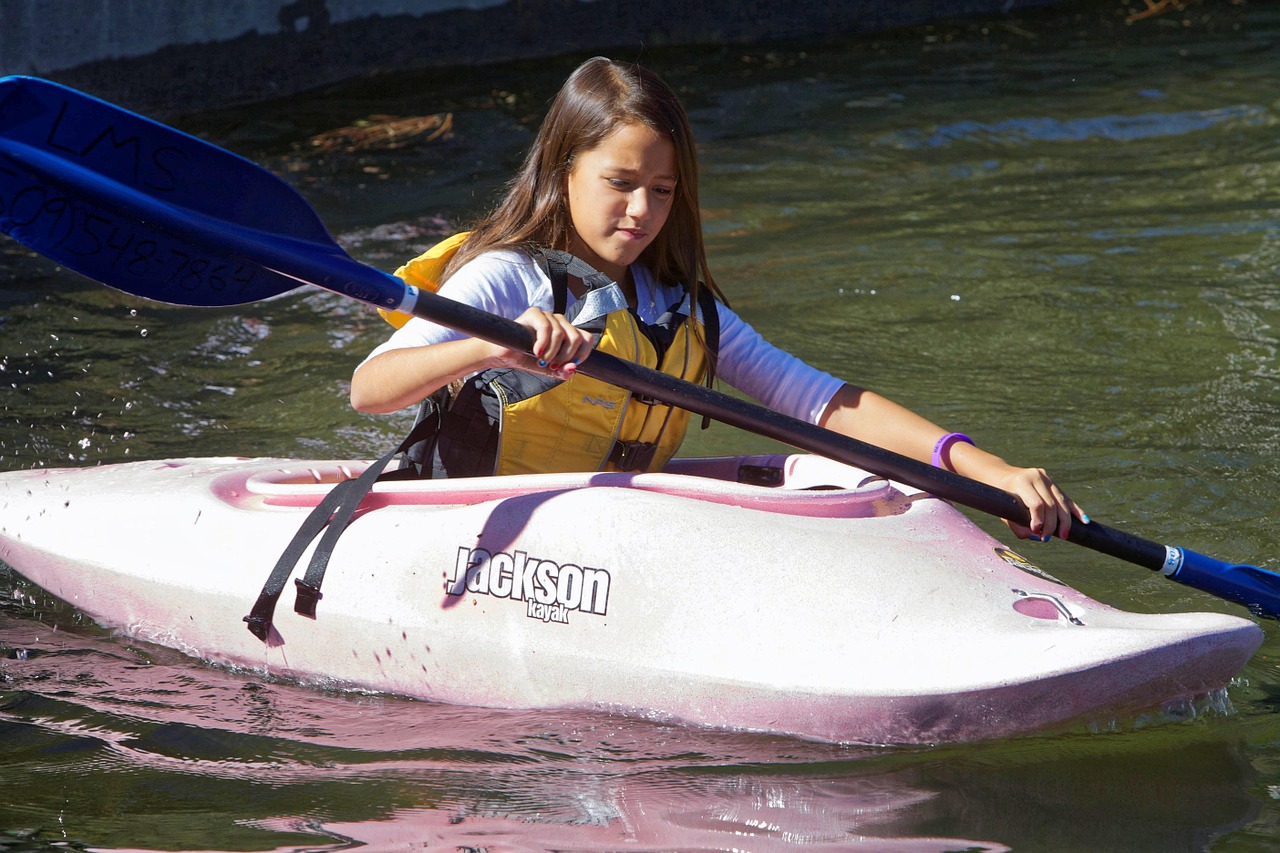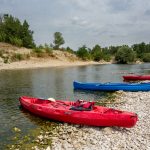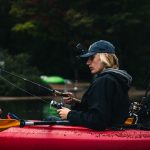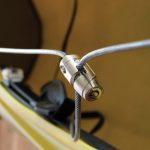Picking your first kayak paddle is a daunting task. In this article, we review some models that we consider the best kayak paddles for beginners. Enjoy!

Kayaking looks fairly intuitive, and most people quickly work out how to move their kayak around in roughly the right direction. But there’s a difference between making your boat move around and paddling your kayak efficiently.
Before we get into how to move the kayak around, it’s worth understanding a few basics of paddling.
Holding Your Paddle
We cover the basics of how a paddle works and how to choose the perfect paddle in our kayak paddle buying guide, but here we need to know how to hold it and use it properly.
The paddle is made of a shaft (the long thin, rounded bit in the middle) which connects the two blades (wing-type bits at the end which go in the water).
Where to Put your Hands on a Paddle
You hold the shaft of the paddle, between the blades. To make sure your hands are in roughly the right place, lower the paddle on to the top of your head. Your elbows should make roughly a 90° angle.
This ‘box’ shape not only promotes the best form for paddling, but also keeps our shoulders in a strong position and limits the chance of injury.
Paddle Blades
Symmetric vs Asymmetric Paddle Blades
Many basic paddle blades are symmetrical. This means the blades are either square or oval, and it doesn’t matter which way up you paddle; they look the same either way.
Asymmetrical blades will be longer on one side of the shaft to the other. This is to help them flow more effectively through the water. The shorter side of the blade should be on the bottom of the paddle.
Flat vs Curved Paddle Blades
If your paddle blade is flat, it doesn’t matter which way round you hold the paddle. But if it’s curved, you want the concave (inside) part of the blade facing you.
Think of it like a spoon. You wouldn’t use the back of a spoon to eat ice cream, so why use the back of a paddle to scoop water?
Paddle Blade Feather
Feather refers to whether your blades are offset against one another. It can be easier to learn to paddle with a non-feathered paddle, but long term you are likely to end up with some degree of feather.
If you do have a degree of feather, you just need to remember to twist your paddle between strokes to make sure your blade always goes in the correct way, and avoid slicing it through the water accidentally.
Paddling Efficiency
Using Your Core to Paddle
We want to be as efficient as possible when we paddle and that means using the right muscles. Our arms might be strong, but our core will be stronger and over the course of hours or days, our arms will tire out and our paddling will become inefficient.
Think of your core as being like a sprung coil.
When wound, a spring has potential power stored in it, ready to unwind and release that power.
We wind our bodies, or spring, up when we reach for a paddle stroke. Twisting, or unwinding our bodies, is our release of power, like a release of a spring.
Unwinding our bodies in one direction can often, in turn, wind it in the other and eventually we create a fluid motion of winding and unwinding to create power.
Paddling Posture
Using your core muscles is only possible by having proper posture in a boat, which comes from making sure the boat fits us properly.
We should sit upright, with our head above our butt, and our feet on the foot rest. Our backrests can be supportive, but we should be able to hold ourselves upright with our core.
Leaning back in a reclined position is not only bad for your back, but is poor paddling form.
Our arms should remain within the paddlers ‘box’ that we mentioned earlier, and we should turn from our shoulders to generate power.
If we can be more connected, with hip pads, thigh straps/pads and back bands, we can often be more efficient.
Forward Paddling Technique
It seems simple, right? But if you want to paddle your kayak all day and do so efficiently, you need to know a bit of technique.
Reach and Plant Your Paddle
Initiate your paddle stroke by winding up your body and reaching your blade towards your feet and planting it in the water, with the blade perpendicular to the kayak.
Push and Twist
It’s not a pull! Pulling implies that we’re going to use the muscles in our arms, but our core muscle group is much more efficient.
Push with your top hand, and rotate your body until the blade is in line with your hips. If it helps, following the path of your paddle with your eyes will promote this twist, but don’t forget to look where you’re going.
Your paddle should run roughly parallel to the side of the kayak.
Recover
As the blade passes your hips, slice it out of the water and twist your paddle (if it’s feathered) so the opposing blade is lined up and ready.
Reach
You should now be in position and your body wound up properly to plant the blade and begin the process again, on the other side of your boat.
Top Tip: For effective forward paddling, a more vertical paddle is usually better for generating power.
Backwards Paddling Technique
Also useful for slowing your kayak down, or controlling your speed, backwards paddling is essentially the opposite of forward paddling.
Plant Your Paddle
Wind up your body again and plant your paddle at your hip with the blade perpendicular to the kayak.
Push and Twist
Push your paddle forwards, running parallel alongside the kayak. Unwind and twist your body, as with the forward paddle stroke, to use your core muscles.
Recover
As your paddle reaches towards your toes, lift it out the water and plant the opposite blade, ready to go again.
Top tip: You don’t have to spin the paddle around. The blade should still be the same as on a forward stroke. This may seem odd, but when you need to slow down or reverse quickly, you won’t have time to spin a paddle.
How to Turn in a Kayak
If a vertical, or roughly vertical, paddle stroke, which follows parallel to the side of the kayak, is effective to propel the boat forwards, then it follows that the opposite would be true of a turning stroke.
Plant Your Paddle
Plant your paddle in at your toes, more horizontally than you would for a forward paddle stroke.
Arc and Twist
To turn our kayaks we want to produce a wider, arcing stroke. Keeping your leading arm almost straight, twist and unwind your body as though following a semi-circle between your toes and the hull at the rear of your kayak.
The wider the arc, the more fluid the turn will be, hence the horizontal paddle.
Recover
As the blade passes our seating position and pulls in towards the stern of the kayak, slice it from the water.
From here, you can either repeat the process to turn the boat further, or go back to your normal forward paddle stroke.
Handy hint: Sometimes we only need to turn our boats a little, and half of a turning stroke may be enough, recovering the blade sooner than suggested here. You will get a feel for how much you need to turn.
How to Move Sideways in a Kayak: Draw Strokes
Draw strokes move us sideways, which can be useful to move towards docks or other kayaks if we want to raft up.
These strokes can be difficult and can feel unstable. They don’t generate loads of power, but they are effective for a purpose.
Twist Your Body
Turn your body to face the object you want to move towards. Turning comes from your shoulders, not your head.
Plant Your Paddle
Facing your direction of travel, reach out your paddle blade and plant it in the water. The blade should be facing you and running parallel to your kayak.
Pull
Pull your blade in towards your hip. Stop before you hit the side of the boat.
Keep your top hand in place, with your top wrist as though you’re reading the time off your watch, this keeps your shoulders in a secure position.
Recover
Stopping before your paddle hits the boat, and avoiding knocking your knuckles off the hull, too, you have two choices here.
For a simple recovery, slice the blade towards the back of the bat and out of the water. You will need to twist your body in order to achieve this.
Alternatively, twist your paddle blade to 90?, so it’s perpendicular to your kayak, and slice it back towards your destination. When your bottom arm is straight, twist it back to your starting position and repeat the draw stroke.
Top tip: Don’t be tempted to push, or pry, the paddle back out from the side of the boat, especially if you catch the blade under the kayak. Instead, release your top hand and allow the paddle to drop into the water. Pick it up and start again.
Pushing makes your boat unstable and can cause a capsize.
How to Paddle a Kayak: Basic Paddle Strokes
Kayaking looks fairly intuitive, and most people quickly work out how to move their kayak around in roughly the right direction. But there’s a difference between making your boat move around and paddling your kayak efficiently.
Before we get into how to move the kayak around, it’s worth understanding a few basics of paddling.
Holding Your Paddle
We cover the basics of how a paddle works and how to choose the perfect paddle in our kayak paddle buying guide, but here we need to know how to hold it and use it properly.
The paddle is made of a shaft (the long thin, rounded bit in the middle) which connects the two blades (wing-type bits at the end which go in the water).
Where to Put your Hands on a Paddle
You hold the shaft of the paddle, between the blades. To make sure your hands are in roughly the right place, lower the paddle on to the top of your head. Your elbows should make roughly a 90° angle.
This ‘box’ shape not only promotes the best form for paddling, but also keeps our shoulders in a strong position and limits the chance of injury.
Paddle Blades
Symmetric vs Asymmetric Paddle Blades
Many basic paddle blades are symmetrical. This means the blades are either square or oval, and it doesn’t matter which way up you paddle; they look the same either way.
Asymmetrical blades will be longer on one side of the shaft to the other. This is to help them flow more effectively through the water. The shorter side of the blade should be on the bottom of the paddle.
Flat vs Curved Paddle Blades
If your paddle blade is flat, it doesn’t matter which way round you hold the paddle. But if it’s curved, you want the concave (inside) part of the blade facing you.
Think of it like a spoon. You wouldn’t use the back of a spoon to eat ice cream, so why use the back of a paddle to scoop water?
Paddle Blade Feather
Feather refers to whether your blades are offset against one another. It can be easier to learn to paddle with a non-feathered paddle, but long term you are likely to end up with some degree of feather.
If you do have a degree of feather, you just need to remember to twist your paddle between strokes to make sure your blade always goes in the correct way, and avoid slicing it through the water accidentally.
Paddling Efficiency
Using Your Core to Paddle
We want to be as efficient as possible when we paddle and that means using the right muscles. Our arms might be strong, but our core will be stronger and over the course of hours or days, our arms will tire out and our paddling will become inefficient.
Think of your core as being like a sprung coil.
When wound, a spring has potential power stored in it, ready to unwind and release that power.
We wind our bodies, or spring, up when we reach for a paddle stroke. Twisting, or unwinding our bodies, is our release of power, like a release of a spring.
Unwinding our bodies in one direction can often, in turn, wind it in the other and eventually we create a fluid motion of winding and unwinding to create power.
Paddling Posture
Using your core muscles is only possible by having proper posture in a boat, which comes from making sure the boat fits us properly.
We should sit upright, with our head above our butt, and our feet on the foot rest. Our backrests can be supportive, but we should be able to hold ourselves upright with our core.
Leaning back in a reclined position is not only bad for your back, but is poor paddling form.
Our arms should remain within the paddlers ‘box’ that we mentioned earlier, and we should turn from our shoulders to generate power.
If we can be more connected, with hip pads, thigh straps/pads and back bands, we can often be more efficient.
Forward Paddling Technique
It seems simple, right? But if you want to paddle your kayak all day and do so efficiently, you need to know a bit of technique.
Reach and Plant Your Paddle
Initiate your paddle stroke by winding up your body and reaching your blade towards your feet and planting it in the water, with the blade perpendicular to the kayak.
Push and Twist
It’s not a pull! Pulling implies that we’re going to use the muscles in our arms, but our core muscle group is much more efficient.
Push with your top hand, and rotate your body until the blade is in line with your hips. If it helps, following the path of your paddle with your eyes will promote this twist, but don’t forget to look where you’re going.
Your paddle should run roughly parallel to the side of the kayak.
Recover
As the blade passes your hips, slice it out of the water and twist your paddle (if it’s feathered) so the opposing blade is lined up and ready.
Reach
You should now be in position and your body wound up properly to plant the blade and begin the process again, on the other side of your boat.
Top Tip: For effective forward paddling, a more vertical paddle is usually better for generating power.
Backwards Paddling Technique
Also useful for slowing your kayak down, or controlling your speed, backwards paddling is essentially the opposite of forward paddling.
Plant Your Paddle
Wind up your body again and plant your paddle at your hip with the blade perpendicular to the kayak.
Push and Twist
Push your paddle forwards, running parallel alongside the kayak. Unwind and twist your body, as with the forward paddle stroke, to use your core muscles.
Recover
As your paddle reaches towards your toes, lift it out the water and plant the opposite blade, ready to go again.
Top tip: You don’t have to spin the paddle around. The blade should still be the same as on a forward stroke. This may seem odd, but when you need to slow down or reverse quickly, you won’t have time to spin a paddle.
How to Turn in a Kayak
If a vertical, or roughly vertical, paddle stroke, which follows parallel to the side of the kayak, is effective to propel the boat forwards, then it follows that the opposite would be true of a turning stroke.
Plant Your Paddle
Plant your paddle in at your toes, more horizontally than you would for a forward paddle stroke.
Arc and Twist
To turn our kayaks we want to produce a wider, arcing stroke. Keeping your leading arm almost straight, twist and unwind your body as though following a semi-circle between your toes and the hull at the rear of your kayak.
The wider the arc, the more fluid the turn will be, hence the horizontal paddle.
Recover
As the blade passes our seating position and pulls in towards the stern of the kayak, slice it from the water.
From here, you can either repeat the process to turn the boat further, or go back to your normal forward paddle stroke.
Handy hint: Sometimes we only need to turn our boats a little, and half of a turning stroke may be enough, recovering the blade sooner than suggested here. You will get a feel for how much you need to turn.
How to Move Sideways in a Kayak: Draw Strokes
Draw strokes move us sideways, which can be useful to move towards docks or other kayaks if we want to raft up.
These strokes can be difficult and can feel unstable. They don’t generate loads of power, but they are effective for a purpose.
Twist Your Body
Turn your body to face the object you want to move towards. Turning comes from your shoulders, not your head.
Plant Your Paddle
Facing your direction of travel, reach out your paddle blade and plant it in the water. The blade should be facing you and running parallel to your kayak.
Pull
Pull your blade in towards your hip. Stop before you hit the side of the boat.
Keep your top hand in place, with your top wrist as though you’re reading the time off your watch, this keeps your shoulders in a secure position.
Recover
Stopping before your paddle hits the boat, and avoiding knocking your knuckles off the hull, too, you have two choices here.
For a simple recovery, slice the blade towards the back of the bat and out of the water. You will need to twist your body in order to achieve this.
Alternatively, twist your paddle blade to 90?, so it’s perpendicular to your kayak, and slice it back towards your destination. When your bottom arm is straight, twist it back to your starting position and repeat the draw stroke.
Top tip: Don’t be tempted to push, or pry, the paddle back out from the side of the boat, especially if you catch the blade under the kayak. Instead, release your top hand and allow the paddle to drop into the water. Pick it up and start again.
Pushing makes your boat unstable and can cause a capsize.








